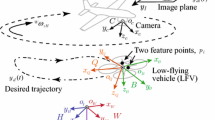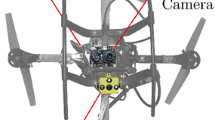Abstract
The problem of developing a reliable system for sensing and controlling the hover of a Micro Air Vehicle (MAV) using visual snapshots is considered. The current problem is part of a larger project, which is developing an autonomous MAV, controlled by vision only information. A new algorithm is proposed that uses a stored image of the ground, a snapshot taken of the ground directly under the MAV, as a visual anchor point. The absolute translation of the aircraft and its velocity are then calculated by comparing the subsequent frames with the stored image and fed into the position controller. In order to increase the performance, several issues, such as effects of scale uncertainty on the closed loop stability of the platform are investigated. For controller design and testing purposes, we analytically derive a complete model of a small size helicopter with no stabilizing bar (flybar). The simulation results for 2D and 3D snapshots confirm the effectiveness of the proposed algorithm.




















Similar content being viewed by others
References
Ahrens, S., Levine, D., Andrews, G., & How, J. (2009). Vision-based guidance and control of a hovering vehicle in unknown, GPS-denied environments. In IEEE international conference on robotics and automation, ICRA’09 (pp. 2643–2648). New York: IEEE Press.
Amidi, O. (1996). An autonomous vision-guided helicopter. PhD thesis, Dept. of Electrical and Computer Engineering, Carnegie Mellon University, Pittsburgh.
Amidi, O., Kanade, T., & Fujita, K. (1999). A visual odometer for autonomous helicopter flight. Robotics and Autonomous Systems, 28(2), 185–193.
Beyeler, A., Zufferey, J., & Floreano, D. (2007). 3D Vision-based navigation for indoor microflyers. In Proceedings of the 2007 IEEE international conference on robotics and automation, Rome, Italy, 10–14 April 2007 (pp. 1336–1341).
Blosch, M., Weiss, S., Scaramuzza, D., & Siegwart, R. (2010). Vision based MAV navigation in unknown and unstructured environments. In IEEE international conference on robotics and automation (ICRA) (pp. 21–28). New York: IEEE Press.
Cartwright, B. A., & Collet, T. S. (1983). How honey bees use landmarks to guide their return to a food source. Journal of Comparative & Physiological Psychology, 151, 521–543.
Cartwright, B. A., & Collet, T. S. (1992). Landmark learning in bees. Nature, 295, 560.
Castillo, C., Alvis, W., Castillo-Effen, M., Valavanis, K., & Moreno, W. (2005). Small scale helicopter analysis and controller design for non-aggressive flights. In IEEE international conference on SMC, Hawaii, October 2005.
Cherian, A., Andersh, J., Morellas, V., Papanikolopoulos, N., & Mettler, B. (2009). Autonomous altitude estimation of a UAV using a single onboard camera. In IROS 2009, IEEE/RSJ international conference on intelligent robots and systems (pp. 3900–3905). New York: IEEE Press.
Corke, P. (2004). An inertial and visual sensing system for a small autonomous helicopter. Journal of Robotic Systems, 21(2), 43–51.
Garratt, M. A. (2007). Biologically inspired vision and control for an autonomous helicopter. PhD thesis, Research School of Biological Sciences, Australian National University, Canberra, Australia.
Garratt, M. A., & Chahl, J. S. (2007). An optic flow damped hover controller for an autonomous helicopter. In Proceedings of the 22nd international UAV systems conference, Bristol, UK, 16–18 April 2007 (pp. 16–18).
Garratt, M. A., & Chahl, J. S. (2008). Vision-based terrain following for an unmanned rotorcraft. Journal of Field Robotics, 25(4–5), 284–301.
Garratt, M. A., Lambert, A., & Guillemette, T. (2009). FPGA implementation of an optic flow sensor using the image interpolation algorithm. In Proceedings of the Australian conference on robotics and automation, Sydney, Australia, 2–4 December 2009.
Griffiths, S., Saunders, J., Curtis, A., Barber, B., McLain, T., & Beard, R. (2006). Maximizing miniature aerial vehicles: obstacle and terrain avoidance for MAVs. IEEE Robotics and Automation Magazine, 13(3), 34–43.
Hung, A., Pickering, M., & Garratt, M. A. (2011). Fast image registration using a multi-pass image interpolation approach. In 7th international conference on information technology and applications (ICITA 2011), Sydney, 21–24 Nov. 2011.
Keyence Corporation (2011). Revolutor H-610 operating instructions. http://hobby.keyence.co.jp/english/manual.html. Accessed 1 Nov. 2011.
Mejias, L., Saripalli, S., Campoy, P., & Sukhatme, G. S. (2006). Visual servoing of an autonomous helicopter in urban areas using feature tracking. Journal of Field Robotics, 23, 185–199.
Mettler, B. (2003). Identification modeling and characteristics of miniature rotorcraft. Norwell: Kluwer Academic.
Mettler, B., Tischler, M. B., Kanade, T., & Messner, W. (2000). Attitude control optimization for a small-scale unmanned helicopter. In AIAA guidance, navigation and control conference (pp. 40–59).
Padfield, G. D. (2007). Helicopter flight dynamics. Ames: Blackwell.
Prouty, R. W. (1990). Helicopter performance, stability, and control. Melbourne: Robert E. Krieger.
Saripalli, S., Montgomery, J. F., & Sukhatme, G. S. (2003). Visually guided landing of an unmanned aerial vehicle. IEEE Transactions on Robotics and Automation, 19, 371–380.
Shakernia, O., Vidal, R., Sharp, C., Ma, Y., & Sastry, S. (2002). Multiple view motion estimation and control for landing an unmanned aerial vehicle. In Proceedings of the IEEE international conference on robotics and automation, Nov. 2002 (Vol. 3, pp. 2793–2798).
Sharp, C. S., Shakernia, O., & Sastry, S. S. (2001). A vision system for landing an unmanned aerial vehicle. In IEEE international conference on robotics and automation.
Srinivasan, M. V. (1994). An image-interpolation technique for the computation of optic flow and egomotion. Biological Cybernetics, 71(5), 401–415.
Zingg, S., Scaramuzza, D., Weiss, S., & Siegwart, R. (2010). MAV navigation through indoor corridors using optical flow. In IEEE international conference on robotics and automation (ICRA) (pp. 3361–3368). New York: IEEE Press.
Acknowledgements
This work was carried out with funding provided by the Australian Defence Science and Technology Organisation.
Author information
Authors and Affiliations
Corresponding author
Rights and permissions
About this article
Cite this article
Garratt, M.A., Lambert, A.J. & Teimoori, H. Design of a 3D snapshot based visual flight control system using a single camera in hover. Auton Robot 34, 19–34 (2013). https://doi.org/10.1007/s10514-012-9310-3
Received:
Accepted:
Published:
Issue Date:
DOI: https://doi.org/10.1007/s10514-012-9310-3




